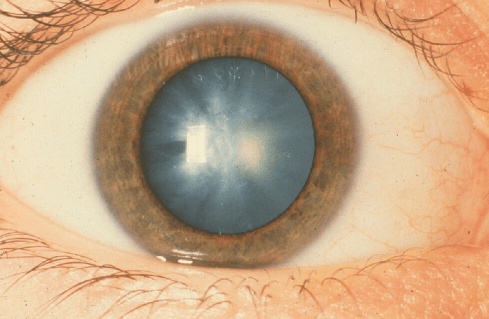Table of Contents
What is Cataract?
Cataract refers to a condition in which there is a masking of the normally clear lens of the eye. For patients suffering from cataracts, vision through the cloudy lens is more like looking through a fogged-up window. This may make it difficult for the patient to drive, read or see a face clearly.

Usually, the condition progresses slowly and does not disturb the eyesight. But with time, cataracts eventually end up interfering with the vision. At first, the condition may seem to be cured by wearing eyeglasses, but surgical intervention may be required if the vision interferes with your usual activities.
Types of cataract
1] Nuclear Cataracts
This type of cataract may initially lead to a problem in viewing the things that are not distant (nearsightedness) or even temporarily improve the reading vision. But as the condition progresses, the yellowing of the lens may increase and may eventually turn it to brown. Advanced yellowing or browning of the lens may make it difficult for a person to differentiate in colors.
2] Congenital Cataracts
Some people may have cataracts from birth or may develop them during childhood. These types of cataracts may be genetic or associated with some kind of infection or trauma.
3] Posterior subcapsular cataracts
This type of cataract starts as a small, opaque area that is generally formed near the back of the lens and falls directly between the path of light. This type of cataract interferes with your vision, makes it difficult for you to see in bright light and causes halos or glare around the light at night. Posterior subscapular cataracts tend to progress at a faster speed.
4] Cortical cataracts
This type of cataract begins as a whitish, wedge-shaped opacity on the outer side of the lens cortex. As the condition progresses, the streaks extend to the centre and begin to interfere with light passing through the centre of the lens.
What are the possible symptoms of a cataract?
Some of the signs and symptoms associated with cataracts include.
- Blurred or clouded vision.
- Sensitivity to light.
- Difficulty to view at night.
- Need for more light to read and do other activities.
- Seeing “halos” around light.
- Yellowing or fading of colors.
- Double vision.
- Frequent changes in the prescription of eyeglass or contact lenses.

Flickr (National Eye Institute)
1] Possible causes of cataract
Cataracts cannot be subjected to a particular cause. They usually develop with age or injury to the tissue that makes up the lens of your eye. Cataracts may also be caused due to genetic disorders, eye conditions or past eye surgery or a medical condition such as diabetes.
2] Possible risk factors of cataract
- Increase in age.
- Diabetes.
- Smoking.
- Obesity.
- High Blood Pressure.
- Injury or inflammation in the eye.
- Prolonged use of corticosteroid medications.
- Excessive alcohol consumption.
Diagnosis and treatment
To detect if the patient has a cataract, the doctor may begin by reviewing the medical history of the patients. He/she may then inquire about the symptoms and perform an eye examination.
Several tests such as visual acuity test, slit-lamp examination and retinal exam may be conducted to ensure if the condition persists.
If the condition is at a very early stage, the doctor may recommend the patient to wear eyeglasses. But in most cases, surgery may be suggested.
1] Preventive measures
Following preventive measures can be taken to ensure that the condition does not progress at a very fast rate.
Undergo regular eye examination – Eye examinations can help to detect the condition at an early stage.
Quit Smoking – Smoking has been seen to negatively impact the condition, therefore smoking must be stopped.
Healthy diet – Eating regular vegetables may help to maintain the health of your eyes as they contain various antioxidants, vitamins and nutrients.
Wear sunglasses – Ultraviolet rays from the sun may contribute to the development of cataracts, therefore wearing sunglasses may help to block the rays.
Reduce alcohol consumption – Lowering the consumption of alcohol may help to reduce the progression of cataracts.
If you are looking for an eye care facility that has the best doctors and modern equipment to treat cataracts, Narayana Nethralaya is the right place for you. The hospital is solely dedicated to providing the best eye care to the patients.

